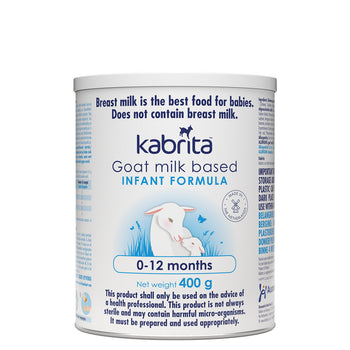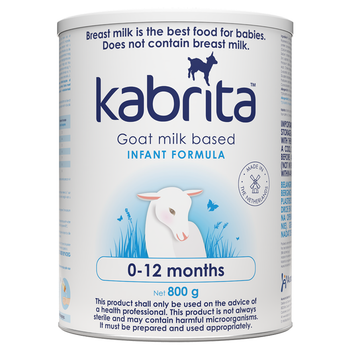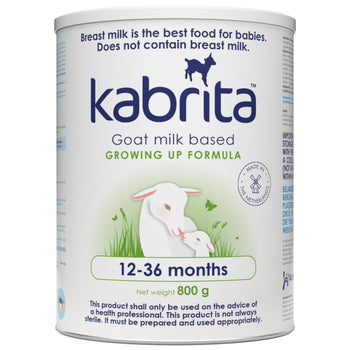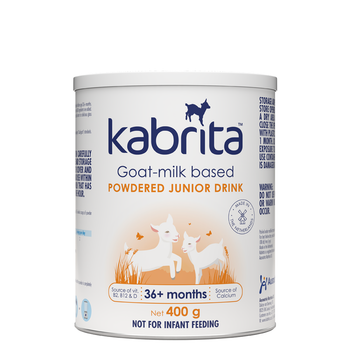Is Kabrita Goat Milk Formula a Symptom Solver?
Information for Health Professionals
We recently sent a survey to our valued community of healthcare professionals. We asked: Does Kabrita help resolve symptoms commonly present in early childhood? The responses were overwhelmingly positive!

Of the 159 health professionals surveyed, 85% agreed that older infants and toddlers who switched to Kabrita Goat Milk Toddler Formula from another source of nutrition such as cow’s milk or other infant formula, experienced relief from symptoms of gas, bloating and discomfort. Additionally, between 60-70% of health professionals agreed that Kabrita helped resolve symptoms of constipation, diarrhea, reflux and/or excessive spit-up and minor skin issues.
Collectively, 9.3% of responses were ‘don’t know.’ This percentage reflects the average responses of 159 health professionals across all 5 common feeding symptoms of gas, excessive spit-up or reflux, loose stool or diarrhea, constipation and minor skin issues.
Functional symptoms in children are common
Digestive discomforts such as reflux, gas, stool inconsistencies and minor skin irritations are some of the most common concerns in pediatric health care1,2. These symptoms can have various underlying causes, including dietary triggers.
5 features that make Kabrita a gentle option

We believe that it is not one, but many features that help explain why health professionals are able to report symptom resolution with the use of Kabrita Goat Milk Toddler Formula.
-
Goat milk protein forms smaller, softer curds during digestion
Gas, boating and discomfort are especially common pediatric disturbances that can range in severity from minor to more distressing. Gas can appear in the upper GI tract in the form of burping as well as the lower GI tract in the form of abdominal distention and flatulence. Differences between cow and goat milk proteins may impact the ease in which milk moves through the upper and lower digestive system. Goat milk protein forms smaller, softer curds during digestion than cow milk protein and may move through the digestive system with greater ease3.
-
Kabrita adds additional goat whey to better emulate the whey to casein ratio of breast milk
Spit-up and reflux can range in severity; anything from happy spitters to more severe discomfort that keep baby and parents up all night. Research suggests that the longer milk stays in the stomach, the more likely reflux may occur4. Kabrita adapts their whey to casein ratio, adding more whey to better emulate the whey to casein ratio of breast milk. Whey stays liquid in the stomach during digestion and may move through the upper digestive tract with greater ease5.
-
Natural and added prebiotics in Kabrita Goat Milk Toddler Formula
Anecdotally, families and health professionals both report that Kabrita may help resolve mild skin issues. Goat milk is a natural source of prebiotics. Goat’s milk, in fact, has 4-10 times the number of natural oligosaccharides compared to cow’s milk. Kabrita also adds prebiotic GOS for additional gut health support. Prebiotics support the development and maintenance of a healthy gut microbiota and have been associated with less atopic presentations in early childhood6.
-
Kabrita Goat Milk Toddler Formula uses a premium fat blend with added Beta-palmitate
Cow’s milk may contribute to stool inconsistencies some children. Studies support, for example, that the elimination of cow milk protein often helps resolve inflammation and motility issues in sensitive populations7. The fatty acid profile in formula may also influence stool consistency in some children. Beta-palmitate, for example, has been shown to benefit the gut microbiota and improve stool consistency8. To learn more about the benefits of beta palmitate, we recommend reading our blog on Palm Oil.
-
Goat milk is A2 milk by nature
Lastly, goat milk is A2 milk by nature which is great news since a number of recently published studies have shown that A1 milk, commonly found in cow’s milk, can cause health issues such as constipation, discomfort, loose stool and bowel inflammation in some individuals9.
We are humbled by the team of dedicated health professionals who continue to spread the gentle word about Kabrita goat milk-based foods and share their valued feedback!

1) Iacono, G., et al., Gastrointestinal symptoms in infancy: a population-based prospective study. Dig Liver Dis, 2005. 37(6): p. 432-8.
2) Gilaberte, Y., Pérez-Gilaberte, J. B., Poblador-Plou, B., Bliek-Bueno, K., Gimeno-Miguel, A., & Prados-Torres, A. (2020). Prevalence and Comorbidity of Atopic Dermatitis in Children: A Large-Scale Population Study Based on Real-World Data. Journal of clinical medicine, 9(6), 1632. https://doi.org/10.3390/jcm9061632
3) Maathuis, Annet∗; Havenaar, Robert∗; He, Tao†; Bellmann, Susann∗ Protein Digestion and Quality of Goat and Cow Milk Infant Formula and Human Milk Under Simulated Infant Conditions, Journal of Pediatric Gastroenterology and Nutrition: December 2017 - Volume 65 - Issue 6 - p 661-666
4) Argon, M., Duygun, U., Daglioz, G., Omür, O., Demir, E., & Aydogdu, S. (2006). Relationship between gastric emptying and gastroesophageal reflux in infants and children. Clinical nuclear medicine, 31(5), 262–265. https://doi.org/10.1097/01.rlu.0000210500.64440.76
5) Meyer, R., Foong, R. X., Thapar, N., Kritas, S., & Shah, N. (2015). Systematic review of the impact of feed protein type and degree of hydrolysis on gastric emptying in children. BMC gastroenterology, 15, 137. https://doi.org/10.1186/s12876-015-0369-0
6) Moro, G., Arslanoglu, S., Stahl, B., Jelinek, J., Wahn, U., & Boehm, G. (2006). A mixture of prebiotic oligosaccharides reduces the incidence of atopic dermatitis during the first six months of age. Archives of disease in childhood, 91(10), 814–819. https://doi.org/10.1136/adc.2006.098251
7) Borrelli, O., Barbara, G., Di Nardo, G., Cremon, C., Lucarelli, S., Frediani, T., Paganelli, M., De Giorgio, R., Stanghellini, V., & Cucchiara, S. (2009). Neuroimmune interaction and anorectal motility in children with food allergy-related chronic constipation. The American journal of gastroenterology, 104(2), 454–463. https://doi.org/10.1038/ajg.2008.109
8) Havlicekova, Z., Jesenak, M., Banovcin, P. et al. Beta-palmitate – a natural component of human milk in supplemental milk formulas. Nutr J 15, 28 (2015). https://doi.org/10.1186/s12937-016-0145-1
9) Brooke-Taylor, S., Dwyer, K., Woodford, K., & Kost, N. (2017). Systematic Review of the Gastrointestinal Effects of A1 Compared with A2 β-Casein. Advances in nutrition (Bethesda, Md.), 8(5), 739–748. https://doi.org/10.3945/an.116.013953



